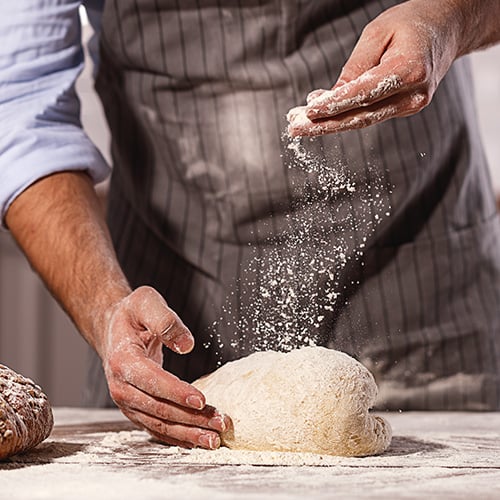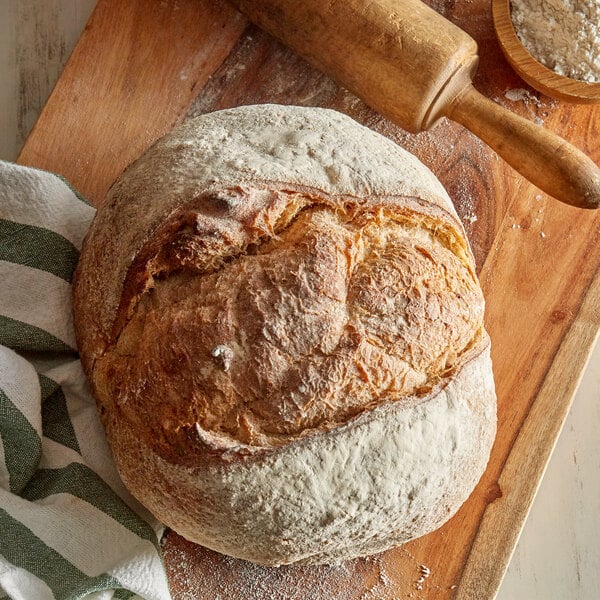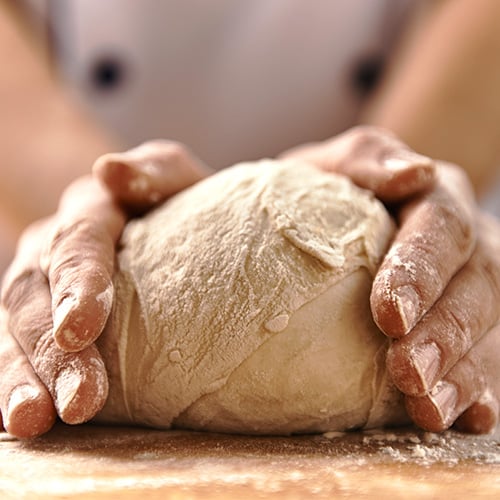What Is Bread Flour?
When creating the ideal texture for loaves of bread, many bakers turn to bread flour. But what exactly is bread flour, and how is it different from all-purpose flour? Bread flour is a high-protein flour that is specifically designed for baking bread. With its strong gluten content, bread flour gives bread a chewier texture and helps it rise higher. Read on to learn the characteristics of bread flour, what it's used for, and how it differs from all-purpose flour.
Shop All Bread FlourWhat Is Bread Flour Used For?

Bread flour is a high-protein flour that typically contains between 12% - 14% protein and is designed for baking yeasted bread. The high protein content means that bread flour has more gluten in it, which makes the dough more elastic and light. It requires significant kneading to create a good gluten structure, which gives bread its chewy, airy texture when baked.
As the name suggests, bread flour is used for making various bread types, like sourdough and white bread. It is also ideal for other recipes where you desire more structure and a chewier consistency, such as pizza dough, flatbreads, pretzels, and bagels.
What Is Strong Flour?
Strong flour, or strong bread flour, is just another name for bread flour that is commonly used in the United Kingdom. There is no difference between bread flour and strong bread flour, strong flour, or hard flour.
Bread flour is sometimes called strong flour because the flour is made from hard wheat varieties, unlike other types of flour.
Bread Flour vs All-Purpose Flour

The main difference between bread flour and all-purpose flour is the type of wheat used and their respective protein contents. Bread flour is made from hard wheat and usually contains 12% - 14% protein. All-purpose flour is made from soft and hard wheat and has an average of 8% - 11% protein. The presence of more protein translates to a higher formation of gluten, which plays a crucial role in the overall texture of bread products. Its ability to create a strong, elastic network of gluten strands gives bread the desired chewy texture and airy rise.
While bread flour is designed for bread-making, all-purpose flour is a more versatile option that can be used in a wide range of recipes. All-purpose flour is best for cakes, cookies, muffins, pastries, and quick breads.
If you're aiming for a crusty, chewy bread with a slightly denser crumb, bread flour is the way to go. Its higher protein content and gluten development contribute to a crustier exterior and a chewier texture. On the other hand, all-purpose flour, with its lower protein content, tends to produce a lighter, softer texture and a thinner crust.
Substitutes for Bread Flour

While bread flour is a staple ingredient in many bread recipes, there are times when you may find yourself without this specific type of flour in your pantry. Luckily, there are a few other types of flour that can be used as a substitute for bread flour in a pinch.
- All-Purpose Flour: As its name suggests, all-purpose flour is a versatile option that can be used in a variety of recipes, including bread. It has a moderate protein content, usually around 8% - 11%, which is lower than bread flour but will still provide volume. Generally, you can swap in unbleached all-purpose flour for bread flour in a 1:1 ratio. You can also add vital wheat gluten to the all-purpose flour, which provides the additional protein needed to create the ideal texture for your bread dough.
- Whole Wheat Flour: Made from grinding whole wheat kernels, whole wheat flour adds a nutty flavor and a hearty texture to your bread. It has a higher protein content than all-purpose flour, typically around 14%, which helps create a good structure in the bread. However, due to its higher fiber content, you may need to adjust the amount of liquid in your recipe to achieve the desired consistency.
- Rye Flour: If you're looking to create traditional rye bread, then rye flour is the best flour type to use in your recipe. It has a low protein content and less gluten than all-purpose flour, creating a unique density in bread baked from it. Rye flour can also be used to create deeply flavorful pumpernickel bread, bring depth to pizza crusts, and feed your sourdough starter.
There are some flour types, like cake or pastry flour, that should not be used as a substitute for bread flour. These flours are relatively low in protein since they are designed to produce tender, fluffy cakes and pastries, so they would not be able to develop the gluten structure needed for the right bread texture and rise.
Whether you're looking to bake fresh white bread or you want to start making sourdough, high-protein bread flour is a great addition to your arsenal of bread-making supplies. Its higher protein content provides the necessary strength and structure for bread dough, resulting in a lighter and chewier texture. Additionally, the increased gluten development in bread flour enhances the rise and volume of baked goods.








